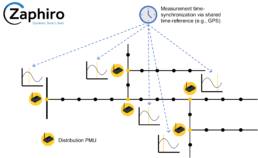Why are time-synchronized measurements important for todays distribution grid operations?

With the current trend of the active distribution network and the integration of inverter-based resources (IBRs) at the distribution level, distribution utilities need to precisely monitor power flows and grid constraint violations in order to guarantee quality and reliability of supply to the end customer. Time-synchronization is key in a range of applications.
Today, the usual approach to distribution grid monitoring is to install conventional sensors and IEDs (e.g. smart meters, fault passage indicators and relays) that report asynchronously voltage/current magnitudes data every few seconds/minutes. More advanced relays can synchronize these measurements within a single substation but measurement synchronization across multiple distribution grid nodes is not yet available.
However, with the advance of time-synchronization technology and grid edge devices, new possibilities open up to distribution utilities. In this article, discover the advantage of time-synchronization for distribution automation.